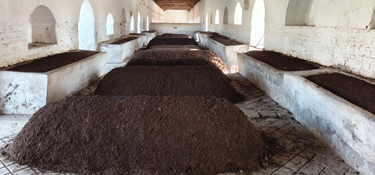Component of INM
Role of organic matter
• Soil organic matter is a vital factor in maintaining long-term soil fertility, as it is the reservoir of nutrients, provides metabolic energy for biological processes and maintaining soil health.
• The application with suitable combinations of organic and inorganic nutrients increased fertilizer use efficiency and sugar yield. The paucity of organic sources of nutrients and their inability to meet the total nutrient requirements to sustain large scale productivity goals, their integrated use with inorganic fertilizers becomes inevitable.
• A large number of experiments conducted on manures and fertilizers on sugarcane in the country indicate that neither the chemical fertilizers alone nor the organic sources exclusively can achieve the production sustainability of soils as well as crop under highly intensive cropping system. Thus, integrated nutrient management would definitely help in achieving the goal.
• Organic manures improve the quality of juice and jaggery due to balanced supply of all essential nutrients in right proportion and slow release throughout the cropping season. Various organic sources like farmyard manure (FYM), oil cakes, press mud cake, vermicompost, green manure, legume as intercrops and sugarcane trash are used as sources of nutrients since ages.
• Organic sources of nutrients not only help in supplementing the nutrients to sugarcane but also maintain favourable physical, chemical and biological soil environment. No single source of plant nutrients i.e. chemical fertilizers, organic manures or bio-fertilizers can meet the entire nutrient demand of crop in intensive agriculture.
• Integrated use of organic along with inorganic fertilizer or trash incorporation with biofertilizers increased cane and commercial cane sugar yield and it was possible to save 25% N when organics was applied along with Azotobactor + PSB.
• The application of organic fertilizer in combination of chemical fertilizers will not only helps sugarcane growing better but also will reduce the cost of cultivation, dependency on the chemical fertilizers, environmental pollution and soil health deterioration. With the raising apprehension on soil conservation and health in the context of depleting traditional organic manures, efforts are required to exploit the potentiality of easily available sources of organics effectively.
Fertilizers
Sugarcane is a long duration and exhaustive crop. Adequate supply of nutrients is essential to boost up the sugarcane production. Fertilizer is the most important component of INM. The use of chemical fertilizer in balanced proportions and in recommended amounts is the quickest way of boosting sugarcane production. Indian soil is mostly deficient in available nitrogen. Hardly, 30 to 40% of the applied fertilizer nutrient is utilized by the sugarcane and the rest is lost through the various pathways like leaching, surface run off, volatilization, denitrification, soil erosion and fixation in soil. Thus, efforts are required to increase the fertilizer use efficiency. Phosphorus and potassium not only improve cane productivity but also sugar recovery by providing resistance against biotic and abiotic stresses and improve synthesis and storage of sugar. Their judicious use improves the response to nitrogen and other costly inputs.
Biofertilizers
• Sustainable agriculture is a long goal that seeks to overcome the problems and constraints that confront the economic viability, environmental soundness and social acceptance of agriculture production systems. In this context, bio-fertilizers assume special significance because they are eco-friendly and also as an alternative of chemical fertilizers.
• Bio-fertilizers are soil energizers containing bacteria in general, which can fix nitrogen and mobilize phosphorus in an eco-¬friendly manner.
• Biofrtilizer are biologically active products, which help in improving plant nutrition stimulating plant growth and accelerating decomposition of the plant residues.
• The commonly used bio-fertilizers in sugarcane are non-symbiotic soil bacteria like Azotobacter, Azospirillum and Acetobacter which contributes significant amounts of nitrogen to sugarcane.
• Phosphobacteria and some fungi also help sugarcane plant to solubilise and assimilate soil phosphorus.
• The saving of fertilizer N to the extent of 25-50 kg/ha was also recorded due to application of biofertilizers.
• The beneficial effects of Azotobacter, Acetobacter and Azospirillumare related not only to their N fixing proficiency but also with their ability to produce antibacterial and anti\fungal compounds and growth regulators resulting increase in yield of sugarcane.
• Azotobacter and Azospirillum alone or in combination with nitrogenous fertilizer significantly increased the sugarcane and sugar yields as compared to the nitrogenous fertilizer alone.



